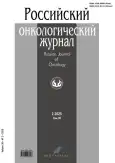Epidemiologic and organizational aspects of remote screening for cutaneous melanoma in the Novgorod region
- Authors: Cherenkov V.G.1,2, Komarova O.A.2, Chistyakova T.V.2, Shonia A.V.2, Tokmachev M.S.1
-
Affiliations:
- Yaroslav-the-Wise Novgorod State University
- Regional Clinical Oncological Dispensary
- Issue: Vol 30, No 2 (2025)
- Pages: 90-100
- Section: Original Study Articles
- Submitted: 26.12.2024
- Accepted: 11.08.2025
- Published: 15.08.2025
- URL: https://rjonco.com/1028-9984/article/view/643457
- DOI: https://doi.org/10.17816/onco643457
- EDN: https://elibrary.ru/BIKBZT
- ID: 643457
Cite item
Abstract
BACKGROUND: Analysis of risk factors and the increasing incidence of cutaneous melanoma in the Novgorod Region, along with the low quality of preventive examinations in older patients, indicates the need for new approaches to detecting melanocytic neoplasms.
AIM: The work aimed to study the epidemiologic features of cutaneous melanoma incidence in the Novgorod Region in order to substantiate optimal approaches to organizing population screening for melanocytic neoplasms using teledermatoscopy.
METHODS: In a pilot project, photomicroscopy of pigmented nevi prone to change (assessed by the ABCDE algorithm) was performed with a portable USB microscope and a standard laptop at the primary screening stage, followed by remote consultation. Three categories of cases were distinguished: 1) low risk of nevus transformation; 2) melanoma-prone nevi (requiring preventive measures); 3) melanocytic dysplasia and melanomas in the horizontal growth phase requiring treatment.
RESULTS: A total of 252 photomicrographs were analyzed after a survey of 1902 patients who reported suspicious moles. Photomicrographic diagnosis using a second reading approach identified superficial melanomas in 6 patients and melanoma-prone nevi in 109 patients, 58 of whom (53.2% ± 2.18%) with a high risk of melanoma underwent surgical treatment. Histologic examination in this group confirmed melanocytic atypia in 8 patients. The remaining patients were followed for 2 years or longer. The risk of melanoma was assessed using the software-hardware complex we developed in an automated mode. The software-hardware complex program generates a library of photographs of suspicious melanocytic skin neoplasms for longitudinal follow-up during dispensary observation. The proposed screening model complements individual mobile teledermatoscopy and increases the effectiveness of national dispensary programs.
CONCLUSION: The findings indicate the effectiveness of teledermatoscopy for detecting melanoma-prone neoplasms using portable, low-cost USB microscopes with a laptop at the primary care level.
Full Text
About the authors
Vyacheslav G. Cherenkov
Yaroslav-the-Wise Novgorod State University; Regional Clinical Oncological Dispensary
Author for correspondence.
Email: v.g.cherenkov@yandex.ru
ORCID iD: 0000-0003-0372-7443
SPIN-code: 8792-1449
MD, Dr. Sci. (Medicine), Professor
Russian Federation, 57 Alexandra Kоrsunov ave, Veliky Novgorod, Russia, 173024; Veliky NovgorodOksana A. Komarova
Regional Clinical Oncological Dispensary
Email: md.komarov@gmail.com
Russian Federation, Veliky Novgorod
Tamara V. Chistyakova
Regional Clinical Oncological Dispensary
Email: orgnovonko@mail.ru
ORCID iD: 0009-0004-9657-0362
SPIN-code: 8868-7167
Russian Federation, Veliky Novgorod
Alexey V. Shonia
Regional Clinical Oncological Dispensary
Email: iwaki95@mail.ru
ORCID iD: 0009-0005-9910-7311
SPIN-code: 8766-6985
Russian Federation, Veliky Novgorod
Mikhail S. Tokmachev
Yaroslav-the-Wise Novgorod State University
Email: mikhail.tokmachov@novsu.ru
ORCID iD: 0009-0009-9417-3773
SPIN-code: 6416-7369
Cand. Sci. (Physics and Mathematics), Assistant Professor
Russian Federation, Veliky NovgorodReferences
- Kaprin AD, Starinsky VV, Shakhzadov AO, editors. Malignant neoplasms in Russia in 2023 (morbidity and mortality). Moscow: P.A. Herzen Moscow Oncology Research Institute — branch of the National Medical Research Center of Radiology of the Ministry of Health of the Russian Federation; 2024. (In Russ.)
- Palkina NV, Ruksha TG. Evaluation of the skin melanoma screening program in the Krasnoyarsk territory in 2017 and 2023: observational retrospective study. Russian Journal of Oncology. 2024;29(1):33–42. doi: 10.17816/onco631750
- Veronese F, Tarantino V, Zavattaro E, et al. Teledermoscopy in the Diagnosis of Melanocytic and Non-Melanocytic Skin Lesions: NurugoTM Derma Smartphone Microscope as a Possible New Tool in Daily Clinical Practice. Diagnostics. 2022;12(6):1371. doi: 10.3390/diagnostics12061371
- Lee C, Witkowski A, Żychowska M, Ludzik J. The role of mobile teledermoscopy in skin cancer triage and management during the COVID-19 pandemic. Indian J Dermatol Venereol Leprol. 2023;89(3):347−352. doi: 10.25259/IJDVL_118_2022
- Cherenkov VG, Pasevich KG, Gulkov IV, et al. Preliminary results of the creation of a robotic complex in the organization of primary diagnosis of risk factors and early forms of cancer. Russian Journal of Oncology. 2018;23(3–6):176–179. doi: 10.18821/1028-9984-2018-23-3-6-176-179
- Cherenkov VG, Pasevich KG, Gulkov IV, Prisyazhnyuk SL. Non-randomized study of a new USB chromomicroscopic method for the diagnosis of superficial spreading melanomas. FARMATEKA. 2020;27(11):42–45. doi: 10.18565/pharmateca.2020.11.42-45
- Zhuchkov MV, Bulinska AK, Kittler G. Application of the algorithm «Chaos and Clues» in assessing dermatoscopy images of pigmented skin lesions. Dermatology (Suppl. Consilium Medicum). 2017;2:5–13. EDN: ZMJCSD
- Merabishvili VM, Demidov LV. Malignant Melanoma of the Skin (C43). Prevalence, Quality of Accounting, Detailed Localization and Histological Structure, Patient Survival (Population Study). Effective Pharmacotherapy. 2024;20(5):84–92. doi: 10.33978/2307-3586-2024-20-5-84-92
- Patent RUS № 2716811/ 16.03.20. Byul. № 8. Cherenkov VG, Pasevich KG, Gulkov IV, et al. Method for early diagnosis of superficial spreading melanomas. Available from: https://rusneb.ru/catalog/000224_000128_0002716811_20200316_C1_RU/ (In Russ.) EDN: THWEJY
- Sivоdedova NA, Karyakin NN, Gamayunov SV, Uskova KA. Review of the results of a survey of users of the “ProRodinki” mobile application used to detect malignant skin tumors on the territory of the Nizhny Novgorod region. HEALTHCARE MANAGEMENT: News, Views, Education. Bulletin of VSHOUZ. 2023;9(4):107–115. doi: 10.33029/2411-8621-2023-9-4-107-115
Supplementary files




















